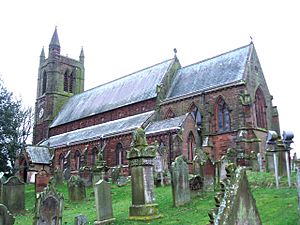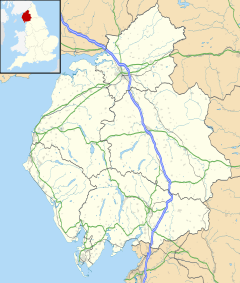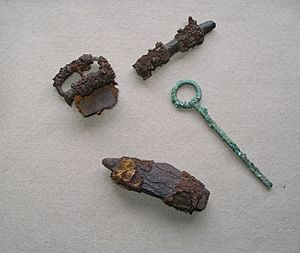Aspatria facts for kids
Quick facts for kids Aspatria |
|
|---|---|
 St Kentigern's Church |
|
| Population | 2,834 (2011) |
| OS grid reference | NY145417 |
| Civil parish |
|
| Unitary authority |
|
| Ceremonial county | |
| Region | |
| Country | England |
| Sovereign state | United Kingdom |
| Post town | WIGTON |
| Postcode district | CA7 |
| Dialling code | 016973 |
| Police | Cumbria |
| Fire | Cumbria |
| Ambulance | North West |
| EU Parliament | North West England |
| UK Parliament |
|
Aspatria /əsˈpeɪtriə/ is a town and civil parish in Cumberland, Cumbria, England. It sits on the north side of the Ellen Valley, offering great views of the countryside. You can see Skiddaw mountain to the south and the Solway Firth to the north.
The town stretches about 2 miles (3.2 km) along the A596 road, which connects Carlisle to Workington. Aspatria is about 8 miles (13 km) northeast of Maryport and a similar distance southwest of Wigton. It's also about 9 miles (14 km) north of Cockermouth and 5 miles (8.0 km) from the coast at Allonby.
Aspatria includes the areas of Aspatria, Brayton, Hayton and Mealo, and Oughterside and Allerby. In total, this area covers about 8,345 acres (3,377 ha). The town itself takes up about 1,600 acres (647 ha). Long ago, a Roman road passed through this area, connecting "Old Carlisle" to Ellenborough.
The town's population has grown a lot since the mid-1800s. In 1801, only 321 people lived here in 98 homes. By 1851, the population had grown to 1,123. It reached 2,714 by 1891 and peaked at 3,521 in the early 1900s. Today, the population is around 2,834 (2011).
Aspatria railway station serves the town. Aspatria is also located near the edge of the beautiful English Lake District. The local church, St Kentigern, was finished in 1848. You can still see old stone pieces and crosses from even earlier buildings on the same spot.
Contents
History
Ancient Times
Aspatria is a very old settlement. It seems to have been home to a group of Norsemen (Vikings) who came from Ireland around 900 AD.
In 1789, a surgeon named Mr. Rigg hired workers to flatten a hill called Beacon Hill. About one meter down, they found a stone-walled space. Inside, they discovered the nearly complete skeleton of a Viking chief. The skeleton was over two meters long!
Next to the giant skeleton was a sword almost two meters long. It had a wide blade decorated with gold and silver on the handle. The scabbard (sword cover) was made of wood and lined with cloth. The workers also found pieces of armour, a small knife (called a dirk) with a silver handle, a gold belt buckle, and a chest plate. These amazing items are now kept at the British Museum. More discoveries were made at the same spot in 1997 when a mobile phone mast was being built.
The Manor's Story
The land of Aspatria has a long history of ownership. It was first given to Waltheof, son of Gospatrick, by Ranulph de Meschines after William the Conqueror took over England. The old name "Aspatrick" might come from Gospatrick's name.
Over many centuries, the ownership of the land changed hands several times through marriages and family lines. It eventually came into the hands of the Percy family, who were the Earls of Northumberland. Later, it passed to the Seymour family and then to the Wyndham family. Today, it belongs to Lord Egremont.
Aspatria is located at the northern end of the West Cumberland Coalfield. People have been mining coal here since the 1500s. When the Maryport and Carlisle Railway opened in 1842, the coal mining industry grew very quickly. Several mines, like the Brayton Domain Collieries, opened around the town. The last coal mine in Aspatria, Brayton Domain No.5, closed in 1940.
In 1870, one of England's first farmer's groups, the Aspatria Agricultural Cooperative Society, was started here. It had offices in the market square, across from the Aspatria Agricultural College. This college was very successful from 1874 until 1925.
Sir Wilfrid Lawson MP (1829–1906) lived at Brayton Hall near the town. He was a strong supporter of the Temperance Movement, which encouraged people to drink less alcohol. His memorial stands in the market square. It has a bronze statue of St. George fighting a dragon, which is said to represent the fight against alcohol. Sadly, Brayton Hall was destroyed by fire in 1918.
What's in a Name?
The name Aspatria has interesting origins. Some say it comes from Old Scandinavian and Celtic words. It means "Ash-tree of St. Patrick." The name combines askr (Old Scandinavian for "ash-tree") and the Celtic saint's name. The way the words are put together, with the tree first, is common in Celtic place names.
Over the years, the name has been spelled in many ways, like Estpatrick, Asepatrick, and Askpatrik. The spelling "Aspatria" first appeared in the church records in 1712. For about 50 years, the spelling changed often until "Aspatria" became the most common.
When famous writers Charles Dickens and Wilkie Collins visited in 1857, they called the town "Spatter." This is similar to "Speatrie," which is what local people often call it. This leads to the funny saying "Speatrie Loup Oot!" (meaning "Speatrie, jump out!"). This phrase came from a railway porter named William Brough. He would shout it to third-class passengers when their train arrived in Aspatria. For second-class passengers, he'd say, "Speatrie change ere for Measyat." And for first-class passengers, he'd politely say, "Aspatriah, change heah for Mealsgate."
There's also a legend that the name comes from an ash tree. The story says that St. Patrick's staff took root in the ground and grew into an ash tree. This happened because it took him so long to convince the local people to become Christians.
The Rev. William Slater Calverley, who was the vicar of St. Kentigern's from 1888 to 1897, wrote about this. He said that people pronounced "Aspatrick" as "S'Patrick." He remembered the railway porter shouting, "S'Patrick, get out!" to third-class passengers.
More recently, Professor William Bailey from the University of Warwick suggested another idea. He thinks the name might come from Latin, meaning "place where asparagus grows." This idea came from his research into how food was supplied to the Roman forts along Hadrian's Wall.
Governance
Aspatria is part of the Penrith and Solway area for the UK Parliament. Since the 2024 general election, the town is represented by Markus Campbell-Savours from the Labour Party.
Before 2019, the Labour Party had won the local seat in almost every general election since 1979. However, in the December 2019 election, the Tory candidate, Mark Jenkinson, won the seat for Workington.
Aspatria also has its own electoral ward (a local voting area). This ward includes areas stretching east to Allhallows. In 2011, the total population of this ward was 3,380.
Religious Worship
Before the coal mines opened, Aspatria had two places of worship. There was the long-standing Anglican parish church of St. Kentigern's. There was also a non-conformist chapel built by Sir Wilfrid Lawson in 1826. This chapel is now a café.
As more workers moved to Aspatria, new churches were needed. In 1864, the Primitive Methodists built a chapel. Twenty years later, they built a larger one with a home for their minister. The original building became a Sunday school.
In 1874, a group called the Bible Christians built a chapel. The Wesleyan Methodists built their first chapel in 1898, and then a larger one in 1921. Although there are a small number of Roman Catholics in Aspatria, they have never built their own church.
Education
There are two primary schools in Aspatria: Oughterside Primary School and Richmond Hill School.
Beacon Hill Community School is the secondary school in Aspatria. It serves students from the town and nearby villages.
Neighbouring Parishes
Aspatria is surrounded by several other parishes. To the north are Bromfield and Westnewton. To the west are Gilcrux and Crosscanonby. To the south are Plumbland and Torpenhow. And to the east are Bromfield and Allhallows.
Industry
Aspatria has a small industrial area near the railway station. Here you'll find:
- Mattress maker Sealy has had its British head office here since 1974. However, it was announced in May 2020 that the factory would close.
- First Milk creamery (which used to be owned by the Milk Marketing Board). This is a farmers' group that makes Lake District Cheese. It's now the third best-selling Cheddar cheese in the UK. They make 60 tonnes of cheese every day, using 800,000 litres of milk!
- Aspatria Farmers Limited, which used to be the Aspatria Agricultural Cooperative Society.
Media
For local news and TV shows, people in Aspatria can watch BBC North East and Cumbria and ITV Border. TV signals come from the Caldbeck TV transmitter.
Local radio stations include BBC Radio Cumbria on 94.7 FM and Greatest Hits Radio Cumbria & South West Scotland on 96.4 FM. The local newspaper for the town is the News and Star.
Sport
Aspatria has several sports teams:
- Aspatria Hornets are the local rugby league team.
- Aspatria RUFC is the town's rugby union club. They currently play in the RFU's North Lancashire/Cumbria Division. The 'Aspatria Eagles' are the club's second team, and the 'Aspatria Sinners' are the women's team.
- Aspatria FC is the town's football club. They play in the Tesco Cumberland County Premier League.
Notable people
- Sheila Fell, artist, born in Aspatria
- Jenny Cowern, artist, lived at Langrigg, Aspatria
- Thomas Holliday, rugby international, had a business in Queen Street
- Sir Wilfrid Lawson, 2nd Baronet of Brayton, a politician and campaigner for less alcohol consumption
- Henry Thompson, a veterinary surgeon and pioneer in farming
- Greg Ridley, Rock musician
- William Thompson Casson, coach designer and maker
- Rev. William Slater Calverley, an expert in old history and artifacts
- Thomas Farrall, author, teacher, and farmer
- Henry J. Webb, principal of Aspatria Agricultural College
- Roland Stobbart, Speedway rider
- Maurice Stobbart, Speedway rider
- Dr William Perry Briggs, Medical Officer of Health for Aspatria (1892–1928)
See also
In Spanish: Aspatria para niños



